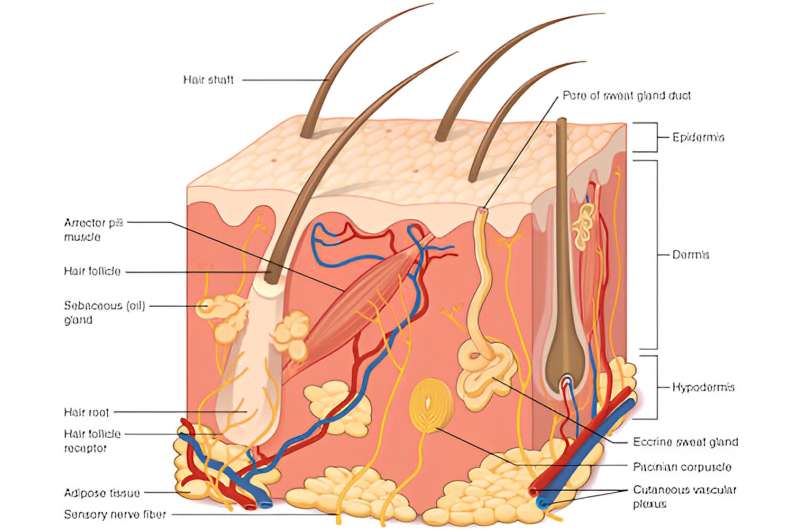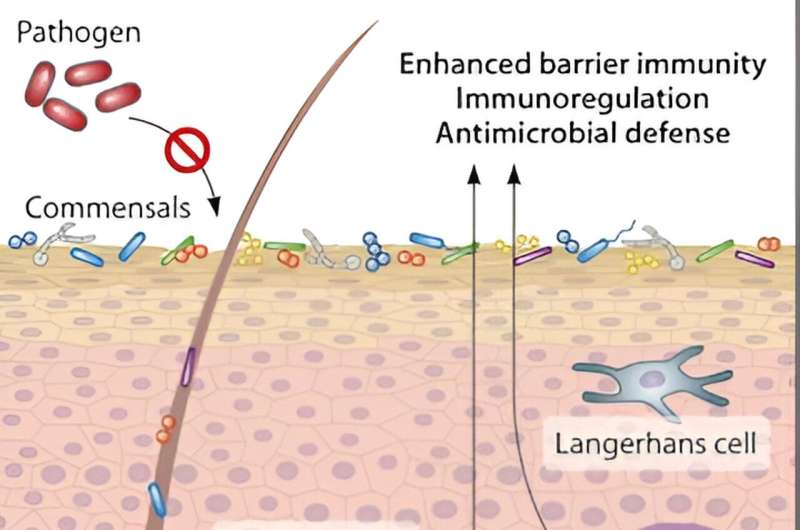This article has been reviewed according to Science X's editorial process and policies. Editors have highlighted the following attributes while ensuring the content's credibility:
fact-checked
peer-reviewed publication
trusted source
proofread
How bacteria support wound healing

Although they were not recognized as agents of disease until the late 19th century, the detrimental effects of bacterial infections have been known to humans for thousands of years. Some have even become mythical—for example, during the American Civil War (1861–1865), flesh wounds that "glowed" in the dark were thought to have a lower infection risk and a better chance of healing.
The origins of this folklore are unclear, but accounts refer to the Battle of Shiloh (1862), which left more than 16,000 soldiers wounded in cold Tennessee mud as they waited for field medics—the perfect conditions for shrapnel and dirt to spur infections in their wounds.
Why exactly some wounds would have glowed, as well as what the glow could have had to do with healing, remained a mystery until 2001, when two high school students presented their work at the Intel International Science and Engineering Science Fair. Their research, supported by the USDA Agricultural Research Service, showed that a bioluminescent insect pathogen called Photorhabdus luminescens could have survived in the wounds of soldiers with hypothermia, where they may have produced antibiotics that can inhibit the growth of other, infection-causing bacteria.
The microbes also glow a cool blue, earning the folkloric nickname "Angel's Glow" for P. luminescens-infected wounds. Though hard evidence for Angel's Glow at Shiloh is sparse, a text from 40 years prior describes a "slight phosphorescence of a slight wound in the leg" occurring at the Siege of Mannheim in Germany (1795), suggesting that this phenomenon could have occurred both there and elsewhere.
The takeaway from the story is that although they are usually thought of as agents of disease, including particularly nasty wound infections like gangrene, bacteria can also be important for wound healing.
Wound healing itself is a very complex process, involving not only the skin, but also the immune and circulatory systems as the skin surface and underlying tissues patch themselves back up. To add another layer of complexity, the human skin surface is home to a bustling microbiota, including bacteria, fungi and viruses that can aid and hamper this delicate process.
The many functions of the skin microbiota
One of the important functions of the skin microbiota is to keep pathogens away from healing wounds, which double as prime entry sites for microorganisms. This can be accomplished directly through the production of antimicrobial molecules that kill potential threats, or indirectly when resident bacteria interfere with the disease-causing mechanisms of pathogens. Another indirect mechanism is for members of the skin microbiota to kick their host's immune system into high alert.
The skin microbiota can participate, and even initiate, the cascade of immunological responses that is required to heal wounds. For example, members of the skin microbiota are important for triggering the first steps of healing. Commensal bacteria that enter the wounds trigger the activation of immune cells known as neutrophils, which are important for activating fast, innate immune responses. The neutrophils begin to express a chemical messenger called CXCL10 that, in turn, recruits more immune cells and kills other members of the microbiota in the wound to reduce the risk of infection.
One well-studied member of the skin microbiota is Staphylococcus epidermidis, which can promote wound healing in many ways. First, it can produce specific compounds, such as lipoteichoic acid, which limits inflammation and promotes a transition to the proliferative phase of wound healing, where skin cells multiply and close the wound. Second, S. epidermis can also engage with the host's adaptive immune system, encouraging immune cells called T cells to accelerate closure.
Bacteriotherapy to reduce biofilm-forming microbes
Bacterial skin infections affect hundreds of millions of people annually, raising the question—can our native skin microbiota be leveraged to treat these kinds of infections? Chronic wounds, such as ulcers, are often at a high risk of infection because of their long healing time, and thus, prolonged period of vulnerability.
A "bacteriotherapy" approach with Lactobacillus plantarum has been tested on patients suffering from leg ulcers infected with multiple biofilm-forming bacteria. Though the study did not constitute a clinical trial, L. plantarum application to the wounds appeared to reduce the area of the ulcers, as well as the abundance of pathogens, including Staphylococcus aureus and Pseudomonas aeruginosa, which are common biofilm-forming wound infectors.
L. plantarum belongs to a group of bacteria known as Lactic Acid Bacteria (LAB) that are frequently used in probiotic applications. Their frequent use is thanks, in part, to their non-pathogenicity, which confers safety for a variety of applications across health care and food science.
L. plantarum may achieve its effects not only by directly antagonizing wound pathogens, such as P. aeruginosa, but also by interacting with the immune system. L. plantarum treatment seemed to promote the recruitment of neutrophils—those immune first responders—as well as fibroblasts and endothelial cells to the ulcer, which may have contributed to the improved granulation. However, the exact mechanisms, as well as an approved bacteriotherapy treatment, are still elusive.

Engineering bacteria to promote wound healing
In addition to bacteriotherapy approaches to treat wound infections, methods of engineering bacteria to perform specific functions in wound environments are being investigated. Because of rampant, ever-increasing resistance, we desperately need to move away from antibiotics as a primary therapeutic strategy for all kinds of bacterial infections, including those of the skin. One option is to engineer bacteria that are specifically designed to carry out the beneficial functions of the normal skin microbiota, such as modulation of the immune system.
One example of this technique in action comes from a recent study where researchers engineered a bacterium called Limosilactobacillus reuteri R2LC to produce the human immune chemical messenger CXCL12-α when introduced into a wound. They performed a randomized, blinded and placebo-controlled human study on the treatment, called ILP100-Topical. In addition to being well-tolerated by test subjects, reapplication of ILP100-Topical also helped to shorten healing time and increased the proportion of healed wounds after 19 days.
Studies like this are still few and far between, making them even more special. "I am extremely proud that we have made it all the way to the first in-human study with this project that was started in the lab by one of my Ph.D. students," said Professor Mia Phillipson from Uppsala University in Sweden, whose research group conducted the study. "This is the first study to be published where this approach was tested in humans to accelerate the healing of induced skin wounds," she explained.
The skin: A new frontier?
The skin is the human body's largest organ, and the first barrier of defense for everything inside against everything outside. The skin microbiota inhabits the surface of this barrier, where the inside can occasionally meet the outside, prompting battles for colonization and protection of the host.
This delicate ecosystem clearly holds promise for treating wounds and other skin afflictions, but work remains to be accomplished before wounds are healed by bacteria quicker than you can say "Angel's Glow."
Journal information: Infection and Immunity
Provided by American Society for Microbiology




















